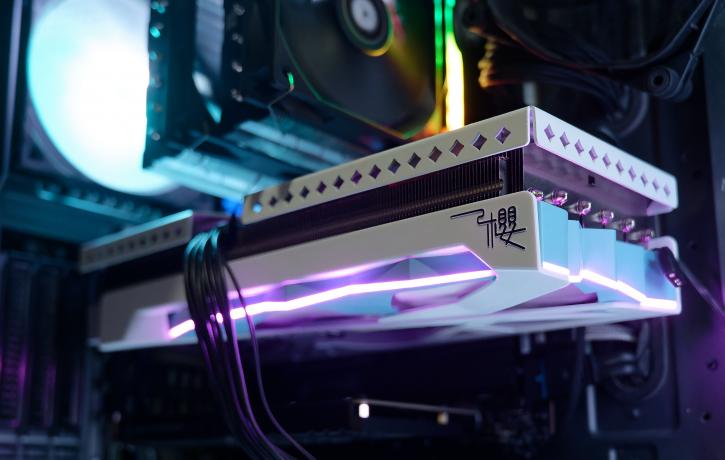Final words and conclusion
Final words
The Yeston Sakura Hitomi version of RTX 4070 Ti is a more-than-decent decent card. It’s performing well (in the range you’d expect from a product from a standard, not OC series). The cooler is plenty enough for this GPU (but not extraordinary). Thanks to the undervolting – this card has a much lower power consumption, fan noise, and temperature while maintaining a similar level of frequency/performance. NVIDIA relies even more heavily on DLSS, with dramatically improved Tensor cores that aid DLSS 3.0, now delivering a twofold performance improvement. NVIDIA claims a 3x or 4x performance improvement with the proper implementation of future titles, which are impressive numbers. There is debate over what the frame injections bring besides more incredible framerates. The new power connector keeps raising concerns, with no clarity from NVIDIA. Bending them too close to the connector, combined with sometimes poor quality, can lead to precarious situations. If you need to bend that cable, do it 3-4cm above the connector level and make sure it’s plugged in deeply and tightly. While overclocking and undervolting can help improve your system’s performance, damaging your hardware is always a risk. Please proceed cautiously and at your own risk (especially for the OC/Tweak process).
Performance
RTX 4070 Ti provides enough performance for enthusiast gamers to play at UWHD and QHD monitor resolutions. This card is designed for precisely that kind of gamer. The RTX 40 series now has a new generation of Ray tracing and Tensor cores that are more powerful. Overall, the GeForce RTX 4070 Ti makes sense at resolutions as low as 2K 2560x1440, up to 4K (3840x2160), but with the DLSS3 enabled, which not all will find pleasing (in quality/smoothness).
Cooling & noise levels
Under heavy full load, the card tested uses about 280 Watts (maximum), with an average in games varied between 190 and 260 W. This Wattage is directly related to how much heat the GPU, which sits inside a closed case, gives off. For acoustics, we reached 39 DB, so not a great result. You can expect the card to get 65-70°C when stressed. This value can increase depending on how well air moves through your chassis. FLIR imaging doesn’t show anything alarming.
Energy consumption
The power draw under intensive gaming for GeForce RTX 4070 Ti is moderate, especially when energy prices are soaring; this product isn’t a good example. We measured it near the 280 Watt range (TBP) under maximum load. In gaming Gaming it fluctuates; however, 250 watts is nothing surprising.
Coil whine
Any GeForce RTX 4070 Ti can exhibit coil squeal. It’s just a matter of how much exactly. Graphics cards all make this in some sort or form, especially at high framerates this can be perceived. In a closed chassis, that noise would fade away in the background. However, you can listen to the coil whine/squeal with an open chassis. The Yeston had no noticeable sound, so that was a bit surprising.
Tweaking (undervolting)
The card tweaks rather average. You receive a strict power limiter in Watts with the tested card. The clock frequency can take a good +100 MHz extra. Apply it, and you’ll see the GPU boost clock hovering at the 2700 MHz domain (frequencies vary per game title as they are dynamic). The memory could be tweaked to 22 Gbps, so all these are decent values that brought 2~3% additional performance on challenging GPU situations, measured from reference performance.
Conclusion
Yeston offers the Sakura Hitomi series as premium graphics cards. The Yeston RTX 4070 Ti Sakura Hitomi has a unique appearance thanks to using three colors for the cooler shroud and backplate. The included converter converts a duo of 8-pin PCIe power connectors into a single 12-plus-four-pin 12VHPWR. Three DisplayPort and one HDMI are available as video outputs. The aluminum backplate has a modern brushed finish and is supplied. There’s no dual-BIOS switch. The GeForce RTX 4070 Ti is doing well in hardware and performance. The 12GB this card offers also is enough for the time being with most titles and the combination of Ultra HD. A good chunk of extra shader cores brings in nearly 1.5x raw shader performance, and even faster Ray-tracing and Tensor cores offer more performance. Underlying technologies like Shader Execution Reordering (SER) and DLSS 3.0 make the new product and Series 4000 shine. The most important part is the undervolting, and after optimizing the settings, the cards had noticeably lower power consumption, temperatures, and fan noise. Summing it up (especially after the undervolting) - the Yeston Sakura Hitomi RTX 4070 Ti deserves an "approved" award for a good performance, original looks, and the potential for the UV process.
You can give yeston a visit here.
- Download NVIDIA GeForce drivers
- Sign up to receive a notification when we publish a new article.
- Or go back to Guru3D's front page



